.gif)
Pinch (plasma physics)
Encyclopedia
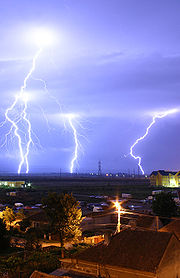
Magnetic field
A magnetic field is a mathematical description of the magnetic influence of electric currents and magnetic materials. The magnetic field at any given point is specified by both a direction and a magnitude ; as such it is a vector field.Technically, a magnetic field is a pseudo vector;...
forces. The conductor is usually a plasma
Plasma (physics)
In physics and chemistry, plasma is a state of matter similar to gas in which a certain portion of the particles are ionized. Heating a gas may ionize its molecules or atoms , thus turning it into a plasma, which contains charged particles: positive ions and negative electrons or ions...
, but could also be a solid or liquid metal
Metal
A metal , is an element, compound, or alloy that is a good conductor of both electricity and heat. Metals are usually malleable and shiny, that is they reflect most of incident light...
. In a z-pinch
Z-pinch
In fusion power research, the Z-pinch, also known as zeta pinch or Bennett pinch , is a type of plasma confinement system that uses an electrical current in the plasma to generate a magnetic field that compresses it...
, the current is axial (in the z direction in a cylindrical coordinate system
Cylindrical coordinate system
A cylindrical coordinate system is a three-dimensional coordinate systemthat specifies point positions by the distance from a chosen reference axis, the direction from the axis relative to a chosen reference direction, and the distance from a chosen reference plane perpendicular to the axis...
) and the magnetic field azimuthal; in a theta-pinch, the current is azimuthal (in the theta direction in cylindrical coordinates) and the magnetic field is axial. The phenomenon may also be referred to as a "Bennett pinch" (after Willard Harrison Bennett
Willard Harrison Bennett
Willard Harrison Bennett was a scientist and inventor, born in Findlay, Ohio. Bennett conducted research into plasma physics, astrophysics, geophysics, surface physics, and physical chemistry...
), "electromagnetic pinch", "magnetic pinch", "pinch effect" or "plasma pinch".
Pinches occur naturally in electrical discharges such as lightning bolt
Lightning
Lightning is an atmospheric electrostatic discharge accompanied by thunder, which typically occurs during thunderstorms, and sometimes during volcanic eruptions or dust storms...
s, the aurora
Aurora (astronomy)
An aurora is a natural light display in the sky particularly in the high latitude regions, caused by the collision of energetic charged particles with atoms in the high altitude atmosphere...
, current sheet
Current sheet
A current sheet is an electric current that is confined to a surface, rather than being spread through a volume of space. Current sheets feature in magnetohydrodynamics , the study of the behavior of electrically conductive fluids: if there is an electric current through part of the volume of such...
s, and solar flare
Solar flare
A solar flare is a sudden brightening observed over the Sun surface or the solar limb, which is interpreted as a large energy release of up to 6 × 1025 joules of energy . The flare ejects clouds of electrons, ions, and atoms through the corona into space. These clouds typically reach Earth a day...
s. They are also produced in the laboratory, primarily for research into fusion power
Fusion power
Fusion power is the power generated by nuclear fusion processes. In fusion reactions two light atomic nuclei fuse together to form a heavier nucleus . In doing so they release a comparatively large amount of energy arising from the binding energy due to the strong nuclear force which is manifested...
, but also by hobbyists (crushing aluminum cans).
Pinch production and types

Nuclear fusion
Nuclear fusion is the process by which two or more atomic nuclei join together, or "fuse", to form a single heavier nucleus. This is usually accompanied by the release or absorption of large quantities of energy...
, such as the Z-pinch machine
Z-pinch
In fusion power research, the Z-pinch, also known as zeta pinch or Bennett pinch , is a type of plasma confinement system that uses an electrical current in the plasma to generate a magnetic field that compresses it...
, and high-energy physics, such as the dense plasma focus
Dense plasma focus
A dense plasma focus is a machine that produces, by electromagnetic acceleration and compression, a short-lived plasma that is so hot and dense that it can cause nuclear fusion and emit X-rays. The electromagnetic compression of the plasma is called a pinch. It was invented in the early 1960s by...
. Pinches may also become unstable
Instability
In numerous fields of study, the component of instability within a system is generally characterized by some of the outputs or internal states growing without bounds...
, and generate radiation across the electromagnetic spectrum
Electromagnetic spectrum
The electromagnetic spectrum is the range of all possible frequencies of electromagnetic radiation. The "electromagnetic spectrum" of an object is the characteristic distribution of electromagnetic radiation emitted or absorbed by that particular object....
, including radio waves
Radio waves
Radio waves are a type of electromagnetic radiation with wavelengths in the electromagnetic spectrum longer than infrared light. Radio waves have frequencies from 300 GHz to as low as 3 kHz, and corresponding wavelengths from 1 millimeter to 100 kilometers. Like all other electromagnetic waves,...
, x-rays and gamma rays, and also neutron
Neutron
The neutron is a subatomic hadron particle which has the symbol or , no net electric charge and a mass slightly larger than that of a proton. With the exception of hydrogen, nuclei of atoms consist of protons and neutrons, which are therefore collectively referred to as nucleons. The number of...
s and synchrotron radiation
Synchrotron radiation
The electromagnetic radiation emitted when charged particles are accelerated radially is called synchrotron radiation. It is produced in synchrotrons using bending magnets, undulators and/or wigglers...
. Types of pinches, that may differ in geometry and operating forces, include the cylindrical pinch, inverse pinch, orthogonal pinch effect, reversed field pinch
Reversed field pinch
A reversed-field pinch is a device used to produce and contain near-thermonuclear plasmas. It is a toroidal pinch which uses a unique magnetic field configuration as a scheme to magnetically confine a plasma, primarily to study magnetic fusion energy. Its magnetic geometry is somewhat different...
, sheet pinch, screw pinch (also called stabilized z-pinch, or θ-z pinch), theta pinch (or thetatron), toroidal pinch, ware pinch and Z-pinch.
Pinches are used to generate X-rays, and the intense magnetic fields generated are used in electromagnetic forming
Electromagnetic forming
Electromagnetic forming is a type of high velocity, cold forming process for electrically conductive metals, most commonly copper and aluminium. The workpiece is reshaped by high intensity pulsed magnetic fields that induce a current in the workpiece and a corresponding repulsive magnetic field,...
of metals (they have been demonstrated in crushing aluminium soft drinks cans). They have applications to particle beam
Particle beam
A particle beam is a stream of charged or neutral particles which may be directed by magnets and focused by electrostatic lenses, although they may also be self-focusing ....
s including particle beam weapon
Particle beam weapon
A particle beam weapon uses an ultra-high-energy beam of atoms or electrons to damage a material target by hitting it, and thus disrupting its atomic and molecular structure. A particle beam weapon is a type of directed-energy weapon, which directs energy in a particular direction by a means of...
s, and astrophysics.
History

Martin van Marum
Martin van Marum was a Dutch scientist and teacher, who studied medicine and philosophy in Groningen...
created an explosion by discharging 100 Leyden jar
Leyden jar
A Leyden jar, or Leiden jar, is a device that "stores" static electricity between two electrodes on the inside and outside of a jar. It was invented independently by German cleric Ewald Georg von Kleist on 11 October 1745 and by Dutch scientist Pieter van Musschenbroek of Leiden in 1745–1746. The...
s into a wire. The phenomenon was not understood until 1905, when Pollock and Barraclough investigated a compressed and distorted length of copper tube from a lightning rod
Lightning rod
A lightning rod or lightning conductor is a metal rod or conductor mounted on top of a building and electrically connected to the ground through a wire, to protect the building in the event of lightning...
after it had been struck by lightning. Their analysis showed that the forces due to the interaction of the large current flow with its own magnetic field could have caused the compression and distortion. A similar, and apparently independent, theoretical analysis of the pinch effect in liquid metals was published by Northrupp in 1907. The next major development was the publication in 1934 of an analysis of the radial pressure balance in a static z-pinch by Bennett
Willard Harrison Bennett
Willard Harrison Bennett was a scientist and inventor, born in Findlay, Ohio. Bennett conducted research into plasma physics, astrophysics, geophysics, surface physics, and physical chemistry...
(See the following section for details.)
Thereafter, the experimental and theoretical progress on pinches was driven by fusion power
Fusion power
Fusion power is the power generated by nuclear fusion processes. In fusion reactions two light atomic nuclei fuse together to form a heavier nucleus . In doing so they release a comparatively large amount of energy arising from the binding energy due to the strong nuclear force which is manifested...
research. In their article on the "Wire-array z-pinch: a powerful x-ray source for ICF
Inertial confinement fusion
Inertial confinement fusion is a process where nuclear fusion reactions are initiated by heating and compressing a fuel target, typically in the form of a pellet that most often contains a mixture of deuterium and tritium....
", M G Haines et al., wrote on the "Early history of z-pinches":
- In 1946 Thompson and Blackman [43] submitted a patent for a fusion reactor based on a toroidal z-pinch [43] with an additional vertical magnetic field. But in 1954 Kruskal and Schwarzschild [44] published their theory of MHD instabilities in a z-pinch. In 1956 Kurchatov gave his famous Harwell lecture showing nonthermal neutrons and the presence of m = 0 and m = 1 instabilities in a deuterium pinch [45]. In 1957 Pease [46] and Braginskii [47] independently predicted radiative collapse in a z-pinch under pressure balance when in hydrogen the current exceeds 1.4 MA. (The viscous rather than resistive dissipation of magnetic energy discussed above and in [32] would however prevent radiative collapse). Lastly, at Imperial College in 1960, led by R Latham, the Plateau-Rayleigh instabilityPlateau-Rayleigh instabilityThe Plateau–Rayleigh instability, often just called the Rayleigh instability, explains why and how a falling stream of fluid breaks up into smaller packets with the same volume but less surface area. It is related to the Rayleigh–Taylor instability...
was shown, and its growth rate measured in a dynamic z-pinch [48]."
One-dimensional configurations
There are three analytic one dimensional configurations generally studied in plasma physics. These are the θ-pinch, the Z-pinchZ-pinch
In fusion power research, the Z-pinch, also known as zeta pinch or Bennett pinch , is a type of plasma confinement system that uses an electrical current in the plasma to generate a magnetic field that compresses it...
, and the Screw Pinch. All of the classic one dimensional pinches are cylindrically shaped. Symmetry is assumed in the axial (z) direction and in the azimuthal (θ) direction. It is traditional to name a one-dimensional pinch after the direction in which the current travels.
The θ-pinch
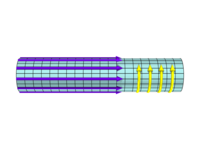
Ampère's law
In classical electromagnetism, Ampère's circuital law, discovered by André-Marie Ampère in 1826, relates the integrated magnetic field around a closed loop to the electric current passing through the loop...
(discarding the displacement term)
Since B is only a function of r we can simplify this to
So J points in the θ direction. θ-pinches tend to be resistant to plasma instabilities. This is due in part to the frozen in flux theorem, which is beyond the scope of this article.
The Z-Pinch
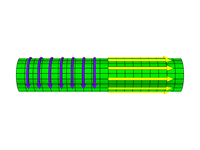
So J points in the z direction. Since particles in a plasma basically follow magnetic field lines, Z-pinches lead them around in circles. Therefore, they tend to have excellent confinement properties.
The screw pinch
The screw pinch is an effort to combine the stability aspects of the θ-pinch and the confinement aspects of the Z-pinch. Referring once again to Ampere's Law
But this time, the B field has a θ component and a z component
So this time J has a component in the z direction and a component in the θ direction.
Two-dimensional equilibria
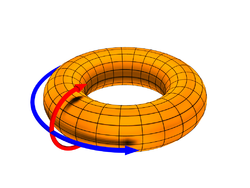
Magnetic mirror
A magnetic mirror is a magnetic field configuration where the field strength changes when moving along a field line. The mirror effect results in a tendency for charged particles to bounce back from the high field region....
s, even these allow many particles to pass. The most common method of mitigating this effect is to bend the cylinder around into a torus. Unfortunately this breaks θ symmetry, as paths on the inner portion (inboard side) of the torus are shorter than similar paths on the outer portion (outboard side). Thus, a new theory is needed. This gives rise to the famous Grad–Shafranov equation.
The one dimensional equilibria provide the inspiration for some of the toroidal configurations. An example of this is the ZETA device at Culham England (which also operated as a Reversed Field Pinch
Reversed field pinch
A reversed-field pinch is a device used to produce and contain near-thermonuclear plasmas. It is a toroidal pinch which uses a unique magnetic field configuration as a scheme to magnetically confine a plasma, primarily to study magnetic fusion energy. Its magnetic geometry is somewhat different...
). The most well recognized of these devices is the toroidal version of the screw pinch, the Tokamak
Tokamak
A tokamak is a device using a magnetic field to confine a plasma in the shape of a torus . Achieving a stable plasma equilibrium requires magnetic field lines that move around the torus in a helical shape...
.
Numerical solutions to the Grad–Shafranov equation have also yielded some equilibria, most notably that of the reversed field pinch
Reversed field pinch
A reversed-field pinch is a device used to produce and contain near-thermonuclear plasmas. It is a toroidal pinch which uses a unique magnetic field configuration as a scheme to magnetically confine a plasma, primarily to study magnetic fusion energy. Its magnetic geometry is somewhat different...
.
Three-dimensional equilibria
There does not exist a coherent analytical theory for three-dimensional equilibria. The general approach to finding three dimensional equilibria is to solve the vacuum ideal MHD equations. Numerical solutions have yielded designs for stellaratorStellarator
A stellarator is a device used to confine a hot plasma with magnetic fields in order to sustain a controlled nuclear fusion reaction. It is one of the earliest controlled fusion devices, first invented by Lyman Spitzer in 1950 and built the next year at what later became the Princeton Plasma...
s. Some machines take advantage of simplification techniques such as helical symmetry (for example University of Wisconsin's Helically Symmetric eXperiment).
Formal treatment
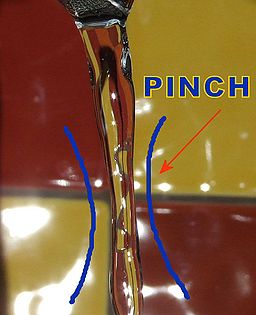
The Bennett relation
Consider a cylindrical column of fully ionized quasineutral plasma, with an axial electric field, producing an axial current density, j, and associated azimuthal magnetic field, B. As the current flows through its own magnetic field, a pinch is generated with an inward radial force density of j x B. In a steady state with forces balancing:- ∇p = ∇(pe + pi) = j × Β
where ∇p is the magnetic pressure gradient, pe and pi is the electron and ion pressures. Then using Maxwell's equation
Maxwell's equations
Maxwell's equations are a set of partial differential equations that, together with the Lorentz force law, form the foundation of classical electrodynamics, classical optics, and electric circuits. These fields in turn underlie modern electrical and communications technologies.Maxwell's equations...
∇ × B = μ0 j and the ideal gas law
Ideal gas law
The ideal gas law is the equation of state of a hypothetical ideal gas. It is a good approximation to the behavior of many gases under many conditions, although it has several limitations. It was first stated by Émile Clapeyron in 1834 as a combination of Boyle's law and Charles's law...
p = N k T, we derive:
 (the Bennett relation)
(the Bennett relation)where N is the number of electrons per unit length along the axis, Te and Ti are the electron and ion temperatures, I is the total beam current, and k is the Boltzmann constant.
The generalized Bennett relation
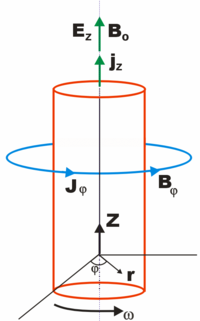

- where a current-carrying, magnetic-field-aligned cylindrical plasma has a radius a,
- J0 is the total moment of inertia with respect to the z axis,
- W⊥kin is the kinetic energyKinetic energyThe kinetic energy of an object is the energy which it possesses due to its motion.It is defined as the work needed to accelerate a body of a given mass from rest to its stated velocity. Having gained this energy during its acceleration, the body maintains this kinetic energy unless its speed changes...
per unit length due to beam motion transverse to the beam axis - WBz is the self-consistent Bz energy per unit length
- WEz is the self-consistent Ez energy per unit length
- Wk is thermokinetic energy per unit length
- I(a) is the axial current inside the radius a (r in diagram)
- N(a) is the total number of particles per unit length
- Er is the radial electric field
- Eφ is the rotational electric field
The positive terms in the equation are expansional forces while the negative terms represent beam compressional forces.
The Carlqvist relation
The Carlqvist Relation, published by Per CarlqvistPer Carlqvist
Per Carlqvist is a Swedish plasma physicist with an interest in astrophysical applications. In 1963, he received the degree of civilingenjör from the Royal Institute of Technology, Stockholm, in 1970 the Tekn. lic., and in 1980 the Tekn...
in 1988, is a specialization of the Generalized Bennett Relation (above), for the case that the kinetic pressure is much smaller at the border of the pinch than in the inner parts. It takes the form

and is applicable to many space plasmas.
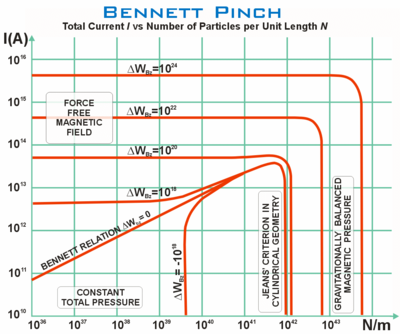
Chart regions: (a) In the top-left region, the pinching force dominates. (b) Towards the bottom, outward kinetic pressures balance inwards magnetic pressure, and the total pressure is constant. (c) To the right of the vertical line ΔWBz = 0, the magnetic pressures balances the gravitational pressure, and the pinching force is negligible. (d) To the left of the sloping curve ΔWBz = 0, the gravitational force is negligible. Note that the chart shows a special case of the Carlqvist relation, and if it is replaced by the more general Bennett relation, then the designated regions of the chart are not valid.
Carlqvist further notes that by using the relations above, and a derivative, it is possible to describe the Bennett pinch, the Jeans criterion
Jeans instability
In physics, the Jeans instability causes the collapse of interstellar gas clouds and subsequent star formation. It occurs when the internal gas pressure is not strong enough to prevent gravitational collapse of a region filled with matter...
(for gravitational instability, in one and two dimensions), force-free magnetic fields
Birkeland current
A Birkeland current is a set of currents which flow along geomagnetic field line connecting the Earth’s magnetosphere to the Earth's high latitude ionosphere. They are a specific class of magnetic field-aligned currents. Lately, the term Birkeland currents has been expanded by some authors to...
, gravitationally balanced magnetic pressures, and continuous transitions between these states.
Crushing cans with the pinch effect

Pulsed power
Pulsed power is the term used to describe the science and technology of accumulating energy over a relatively long period of time and releasing it very quickly thus increasing the instantaneous power.-Overview:...
techniques to produce a theta pinch capable of crushing an aluminium soft drink can by pressure
Pressure
Pressure is the force per unit area applied in a direction perpendicular to the surface of an object. Gauge pressure is the pressure relative to the local atmospheric or ambient pressure.- Definition :...
of strong magnetic field
Magnetic field
A magnetic field is a mathematical description of the magnetic influence of electric currents and magnetic materials. The magnetic field at any given point is specified by both a direction and a magnitude ; as such it is a vector field.Technically, a magnetic field is a pseudo vector;...
.
An electromagnetic aluminium can crusher consists of four main components (1) A high voltage
High voltage
The term high voltage characterizes electrical circuits in which the voltage used is the cause of particular safety concerns and insulation requirements...
DC
Direct current
Direct current is the unidirectional flow of electric charge. Direct current is produced by such sources as batteries, thermocouples, solar cells, and commutator-type electric machines of the dynamo type. Direct current may flow in a conductor such as a wire, but can also flow through...
power supply
Power supply
A power supply is a device that supplies electrical energy to one or more electric loads. The term is most commonly applied to devices that convert one form of electrical energy to another, though it may also refer to devices that convert another form of energy to electrical energy...
which provides a source of electrical energy (2) A large energy discharge capacitor
Capacitor
A capacitor is a passive two-terminal electrical component used to store energy in an electric field. The forms of practical capacitors vary widely, but all contain at least two electrical conductors separated by a dielectric ; for example, one common construction consists of metal foils separated...
to accumulate the electrical energy (3) A high voltage switch or spark gap
Spark gap
A spark gap consists of an arrangement of two conducting electrodes separated by a gap usually filled with a gas such as air, designed to allow an electric spark to pass between the conductors. When the voltage difference between the conductors exceeds the gap's breakdown voltage, a spark forms,...
and (4) A robust coil
Coil
A coil is a series of loops. A coiled coil is a structure in which the coil itself is in turn also looping.-Electromagnetic coils:An electromagnetic coil is formed when a conductor is wound around a core or form to create an inductor or electromagnet...
(capable of surviving high magnetic pressure) through which the stored electrical energy can be quickly discharged in order to generate a correspondingly strong pinching magnetic field (see diagram below).
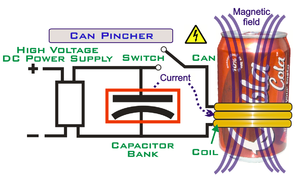
Sam Barros's can crusher cost about $500, and uses a large SCR and a 900 Volt
Volt
The volt is the SI derived unit for electric potential, electric potential difference, and electromotive force. The volt is named in honor of the Italian physicist Alessandro Volta , who invented the voltaic pile, possibly the first chemical battery.- Definition :A single volt is defined as the...
capacitor bank storing about 3000 Joule
Joule
The joule ; symbol J) is a derived unit of energy or work in the International System of Units. It is equal to the energy expended in applying a force of one newton through a distance of one metre , or in passing an electric current of one ampere through a resistance of one ohm for one second...
s of energy. For a very short time, it generates a magnetic field B~5T (250,000 times the strength of the Earth's magnetic field
Earth's magnetic field
Earth's magnetic field is the magnetic field that extends from the Earth's inner core to where it meets the solar wind, a stream of energetic particles emanating from the Sun...
) which has magnetic pressure P ~ 100 atm. Rate of energy conversion (from electric into magnetic and back) in this device is about 22 megawatts
Watt
The watt is a derived unit of power in the International System of Units , named after the Scottish engineer James Watt . The unit, defined as one joule per second, measures the rate of energy conversion.-Definition:...
.
Depictions
A fictionalized pinch-generating deviceExplosively pumped flux compression generator
An explosively pumped flux compression generator is a device used to generate a high-power electromagnetic pulse by compressing magnetic flux using high explosive....
was used in Ocean's Eleven
Ocean's Eleven (2001 film)
Ocean's Eleven is a 2001 American comedy-crime caper and remake of the 1960 Rat Pack caper film of the same name. The 2001 film was directed by Steven Soderbergh and features an ensemble cast including George Clooney, Brad Pitt, Matt Damon, Don Cheadle, Andy García, and Julia Roberts. The film was...
, where it was used to disrupt Las Vegas's power grid just long enough for the characters to begin their heist.
See also
- Madison Symmetric TorusMadison Symmetric TorusThe Madison Symmetric Torus is a reversed field pinch physics experiment with applications to both fusion energy research and astrophysical plasmas located at University of Wisconsin-Madison...
(Reversed field pinch, How to make a toroidal pinch) - Z-pinchZ-pinchIn fusion power research, the Z-pinch, also known as zeta pinch or Bennett pinch , is a type of plasma confinement system that uses an electrical current in the plasma to generate a magnetic field that compresses it...
- Explosively pumped flux compression generatorExplosively pumped flux compression generatorAn explosively pumped flux compression generator is a device used to generate a high-power electromagnetic pulse by compressing magnetic flux using high explosive....
- Magneforming
- List of plasma (physics) applications articles
External links
- Examples of electromagnetically shrunken coins and crushed cans.
- Theory of electromagnetic coin shrinking
- The Known History of "Quarter Shrinking"
- Can crushing info using electromagnetism among other things.
- The MAGPIE project at Imperial College London is used to study wire array Z-pinch implosions.












